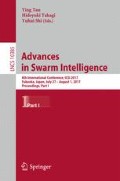Abstract
RNA molecules folded into secondary structure are found to have structure related functionalities. Efficient computational techniques are required for common structural motif identification due to its relevance in the study of various functional aspects. In this work we focus on finding the most frequent descriptor motif inherent in given set of RNA sequences. Our approach uses an efficient computational method incorporating Nature inspired optimization algorithm. The motif skeletons are obtained by applying context free grammar defined for the descriptor motif. Then swarm intelligence based Artificial Bee Colony optimization algorithm is applied to derive the common motif with minimum and maximum length values of each motif element. Optimization process is done based on the objective function defined with the frequency of occurrence as major criterion. This method is able to generate correct motif structures in Signal Recognition Particle data set. The resultant motif is compared with the common motifs generated by other evolutionary methods.
Access this chapter
Tax calculation will be finalised at checkout
Purchases are for personal use only
References
Zuker, M., Stiegler, P.: Optimal computer folding of large RNA sequences using thermodynamics and auxiliary information. Nucleic Acids Res. 9, 133–148 (1981)
Chandra, S.S.V., Reshmi, G.: A Pre-microRNA classifier by structural and thermodynamic motifs. IEEE World Congress on Nature and Biologically Inspired Computing (2009)
Reshmi, G., Chandra, S.S, Babu, V.J., Babu, P.S., Santhi, W.S., Ramachandran, S., Lakshmi, S., Nair, A.S., Pillai, M.R.: Identification and analysis of novel micro RNAs from fragile sites of human cervical cancer: computational and experimental approach. Genomics 97, 333–340 (2011)
Yao, Z., Weinberg, Z., Ruzzo, W.L.: CMfinder—a covariance model based RNA motif finding algorithm. Bioinformatics 22, 445–452 (2006)
Rabani, M., Kertesz, M., Segal, E.: Computational prediction of RNA structural motifs involved in posttranscriptional regulatory processes. Proc. Natl. Acad. Sci. 105, 14885–14890 (2008)
Hamada, M., Tsuda, K., Kudo, T., Kin, T., Asai, K.: Mining frequent stem patterns from unaligned RNA sequences. Bioinformatics 22, 2480–2487 (2006)
Fogel, G.B., William Porto, V., Weekes, D.G., Fogel, D.B., Griffey, R.H., McNeil, J.A., Lesnik, E., Ecker, D.J., Sampath, R.: Discovery of RNA structural elements using evolutionary computation. Nucleic Acids Res. 30(23), 5310–5317 (2002)
Chen, J.H., Le, S.-Y., Maizel, J.V.: Prediction of common secondary structures of RNAs: a genetic algorithm approach. Nucleic Acids Res. 28, 991–999 (2000)
Hu, Y.-J.: GPRM: a genetic programming approach to finding common RNA secondary structure elements. Nucleic Acids Res. 31, 3446–3449 (2003)
Michal, S., Ivry, T., Schalit-Cohen, O., Sipper, M., Barash, D.: Finding a common motif of RNA sequences using genetic programming: the GeRNAMo system. IEEE/ACM Trans. Comput. Biol. Bioinf. 4, 596–610 (2007)
Preeja, V., Abdul, Nazeer, K.A., Vinod Chandra, S.S.: Common structural motif identification in genomic sequences. In: IEEE-ICDSE, pp. 37–41 (2012)
Karaboga, D., Basturk, B.: A powerful and efficient algorithm for numerical function optimization: Artificial Bee Colony (ABC) algorithm. J. Glob. Optim. 39, 459–471 (2007)
Saritha, R., Vinod Chandra, S.S.: A novel algorithm based on honey bee foraging principle for transportation problems. In: ACCIS Proceedings of Elsevier (2014)
Lorenz, R., Bernhart, S.H., zu Siederdissen, C.H., Tafer, H., Flamm, C., Stadler, P.F., Hofacker, I.L.: ViennaRNA package 2.0. Algorithms Mol. Biol. 6 (2011)
Knudsen, B., Hein, J.: Pfold: RNA secondary structure prediction using stochastic CFG. Bioinformatics 31, 3423–3428 (2003)
Author information
Authors and Affiliations
Corresponding author
Editor information
Editors and Affiliations
Rights and permissions
Copyright information
© 2017 Springer International Publishing AG
About this paper
Cite this paper
Suma, L.S., Vinod Chandra, S.S. (2017). Identification of Common Structural Motifs in RNA Sequences Using Artificial Bee Colony Algorithm for Optimization. In: Tan, Y., Takagi, H., Shi, Y. (eds) Advances in Swarm Intelligence. ICSI 2017. Lecture Notes in Computer Science(), vol 10385. Springer, Cham. https://doi.org/10.1007/978-3-319-61824-1_35
Download citation
DOI: https://doi.org/10.1007/978-3-319-61824-1_35
Published:
Publisher Name: Springer, Cham
Print ISBN: 978-3-319-61823-4
Online ISBN: 978-3-319-61824-1
eBook Packages: Computer ScienceComputer Science (R0)

